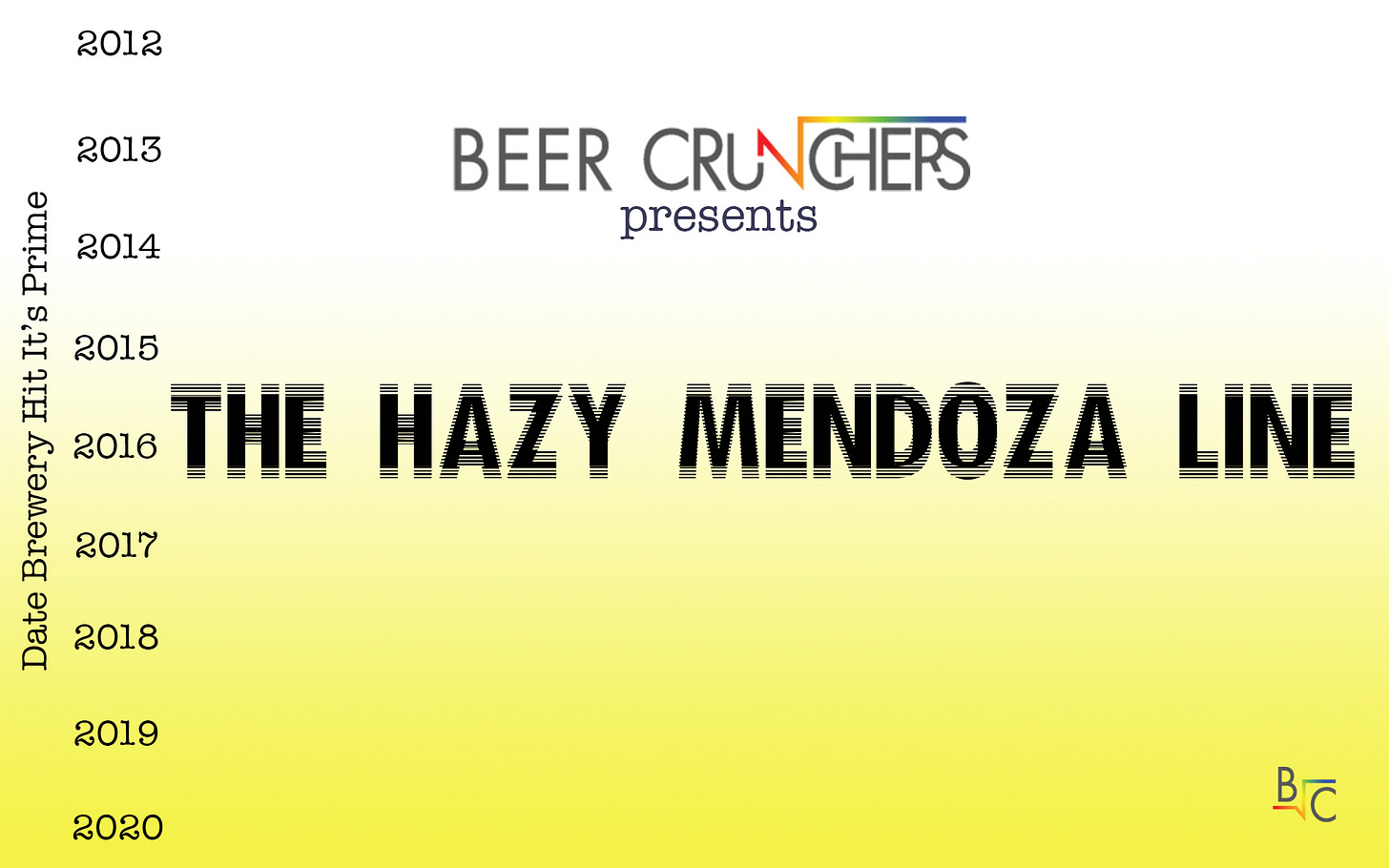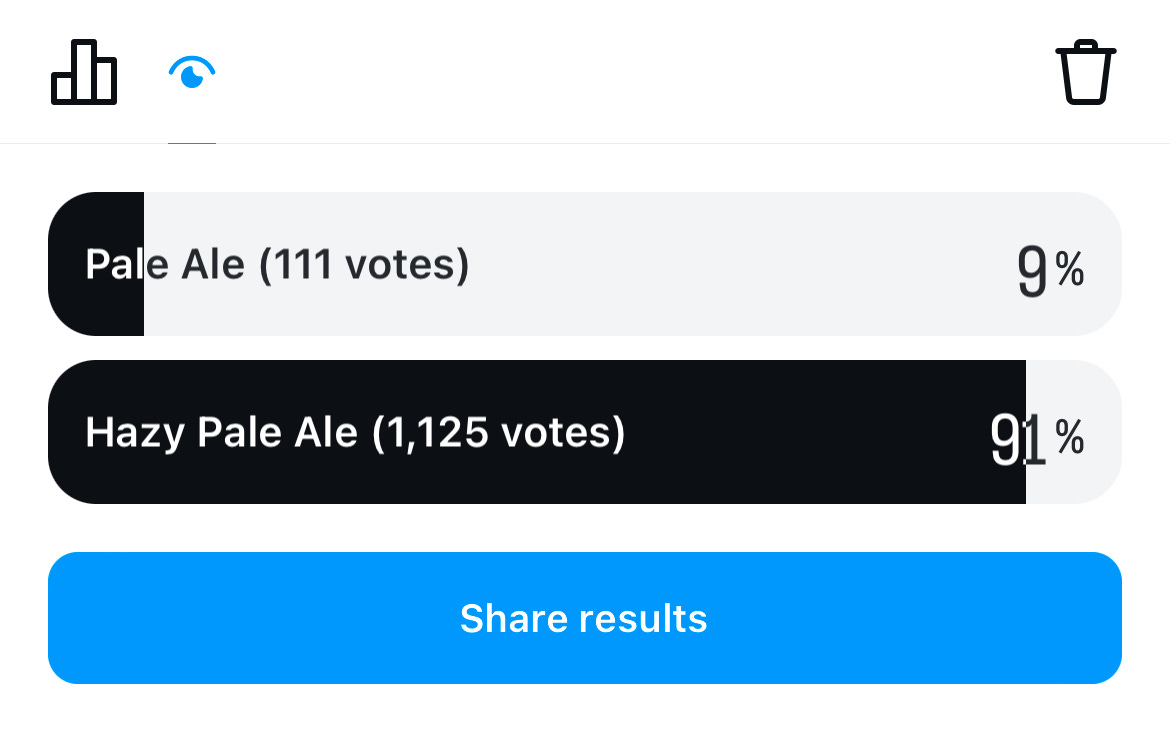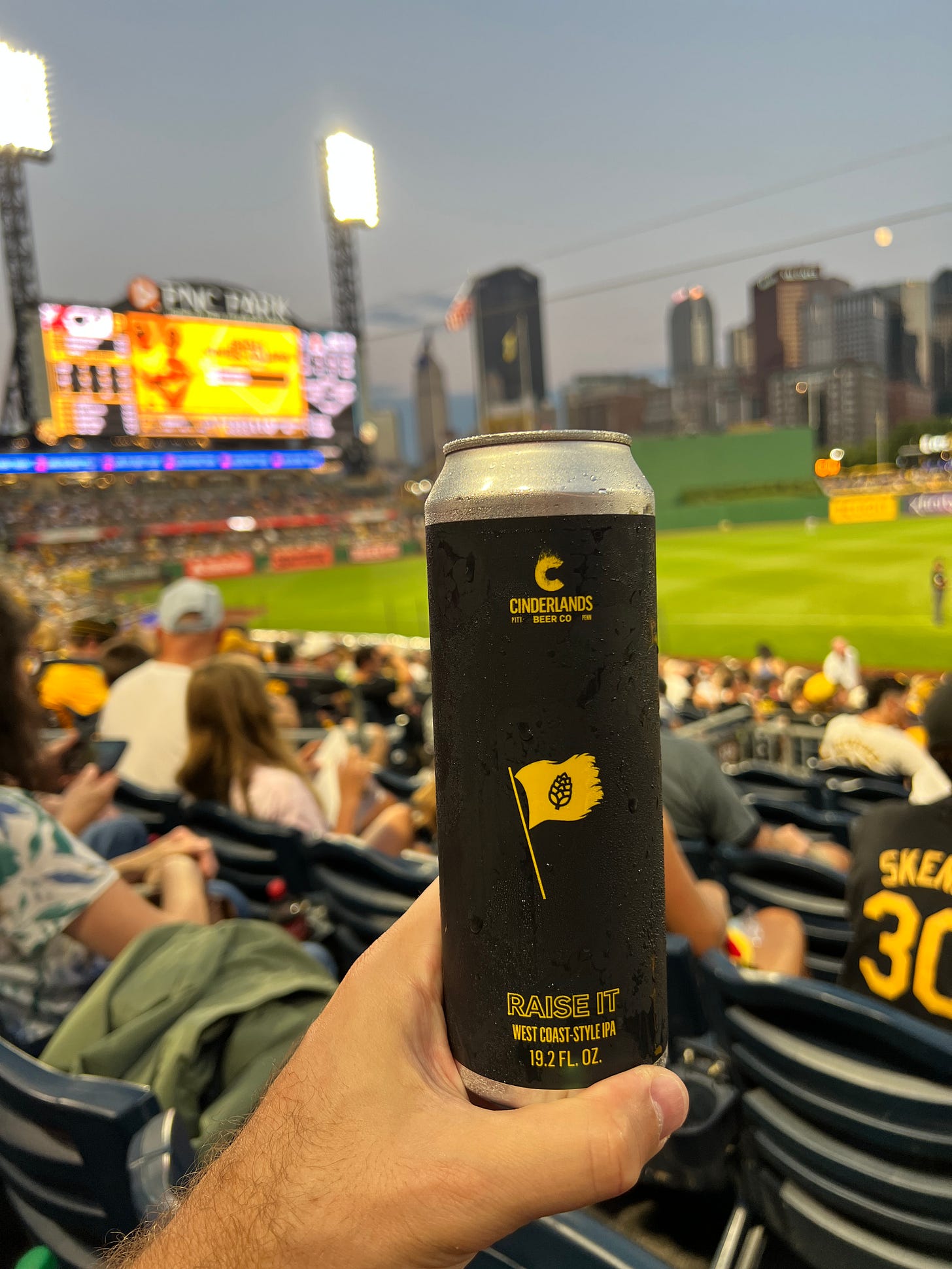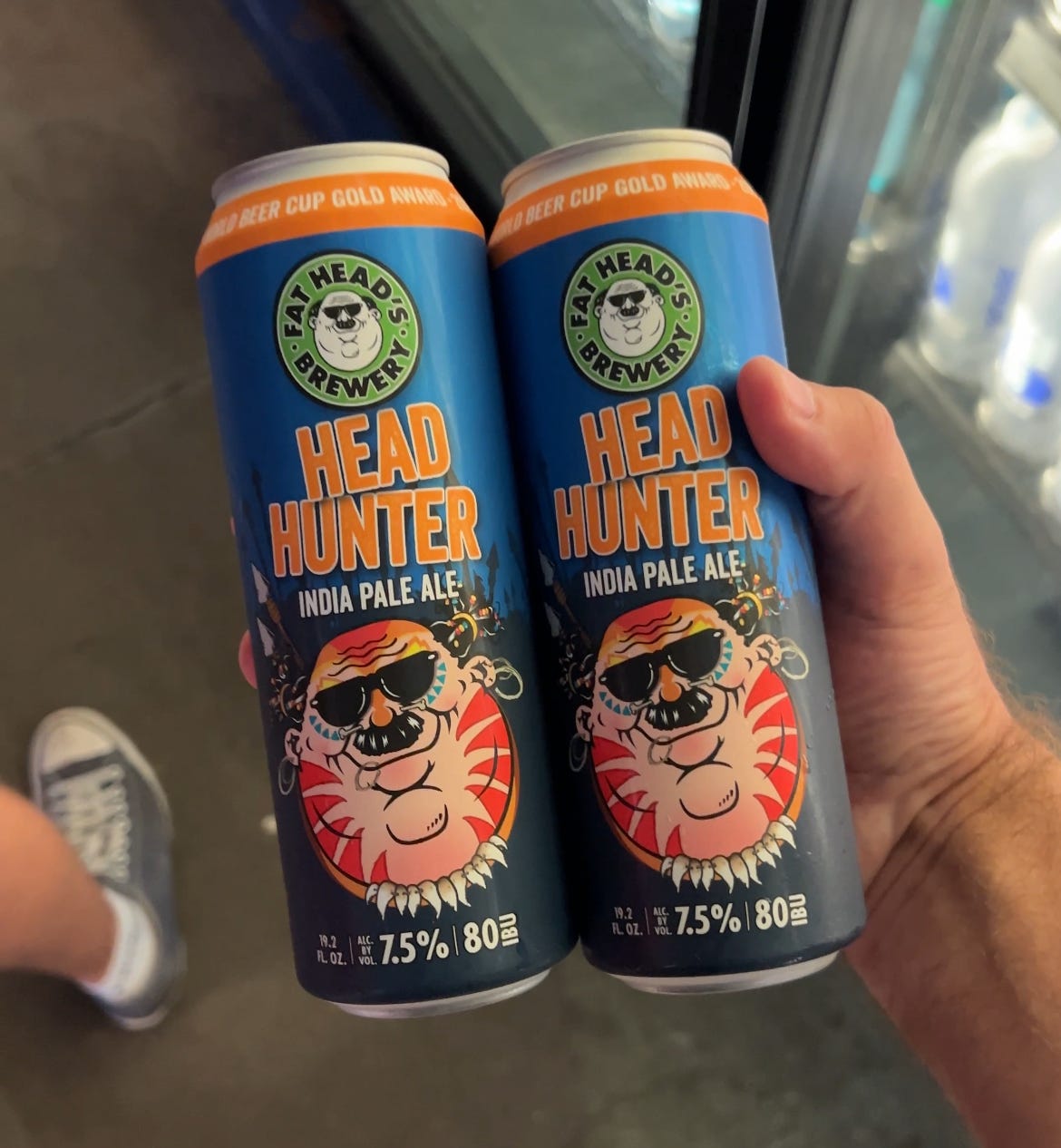The “Mendoza Line” is an old baseball joke coined after Shortstop Mario Mendoza, who was a futile hitter in the late 1970s. When another player, most notably Hall of Famer George Brett, would get off to a slow start, teammates would jab that he’s below the Mendoza Line. The term became synonymous with the imaginary line created by the .200 batting average that Mario carried for most of his career. Craft Beer has it’s own Mendoza Lines, but they’re not about futility. Today’s example is about the two competing sides to IPA terminology, determined by which side of the hazy line they land on.
While in Pittsburgh earlier this month, my family went to dinner at a laidback restaurant in our town. I had been once before and recall being impressed by their beer choices which included local options and stalwarts like Maine Lunch. Before being seated at our table, I perused the draft beer choices on their chalk board and didn’t much that I recognized this time.
Two options from a local brewery with a stellar reputation drew my attention, one labeled “Pale Ale” and the other “American IPA”. Our server looked well under 21, so I didn’t bother asking any inside baseball beer questions and just went for the Pale Ale, while my dad chose the American IPA. Upon arrival, she set down two beers that don’t get any hazier.
Hazy Timing
Every city followed a modified timeline as to when their local beer scene boomed. In Chicago, our most transformational period was from 2010-2015, emphasis on the later half of that window as far as new breweries and widespread discovery and euphoria. During its height, consumers were drinking IPAs and Pale Ales like Daisy Cutter, Ninja Vs. Unicorn, and Anti-Hero, all clear. Nobody cared too much or debated all the delineation of IPA that existed at the time. There were certainly Black, White, Red, Rye, and Wet-hopped IPAs, but these were often treated as seasonal or limited edition and were viewed as complimentary, not as threats to the ecosystem.
The arrival of the Hazy IPA created a fork in the road for many beer fans who all previously steered down a similar path. For markets like Pittsburgh, their boom coincided with Hazy’s arrival approximately around 2016. With Hazy IPAs being the style brining in crowds and lines, that’s what so many new breweries made so that’s how all the new locals were introduced to craft beer. Hazy became the default style, not necessarily in overall volume, but certainly in sheer number of new releases in the explosive local scene. So the more I thought about it, the more I shouldn’t being shocked that when I ordered a Pale Ale, I was served this.
Regional Bias
So I took to Instagram stories to run the poll above to gauge how many people fell on my side of the fence. About 9% of voters were fine with calling my drink above a Pale Ale, where as 91% felt it should be described as a Hazy Pale Ale. While the result is pretty decisive, that’s still a lot of people on the other side as I received a very solid sample of 1,236 unique votes:
What was more fascinating was the number of people in my DMs, probably a record number in a single day for me. I read every single one of them. Most respondents were either local from Pittsburgh or from the Northeast, and explained how many of their favorite breweries call their Pale Ales or IPAs “American” and they’re VERY hazy. In that moment, I felt like my whole life was a lie (kidding 🤪).
The term “American IPA” appears to mean little that can be trusted anymore, at least consistently and nationally for someone traveling, and might as well be shelved completely by the US brewing scene. It’s turned into a filler word to show more intention to the style, but that intention is now be muddy and misleading. The reason I used to like the descriptor is because it could serve as a way to communicate clear and bitter, while letting West Coast IPAs be their more specific versions, still leaving a wide range of variables to incorporate and differentiate with.
But as Don’t Drink Beer jokes 👆 with a meme resembling my dad’s expression 😏above, forget the term “American”. Everything I’ve just laid out is true of the term “IPA” all by itself too, not just when supposedly being more intentional with American. That’s the even bigger point from the standpoint of consumer disappointment. It feels as if our only option to communicate that a beer is clear is to call it a West Coast IPA, but even that plan is far from perfect. Modern approaches to West Coast have been emerging for awhile now, in California especially, with beers that come out hazy.
When attending the Pirates game last Friday, I grabbed the Bucco-themed beer from Cinderlands, one of the leaders of the new wave in the local Pittsburgh scene who opened its doors in 2017. The beer was excellent. Clear, hoppy, and bitter, so what did they call the style? 👇
My first beer of the night though was a Fat Head’s Head Hunter, winner of the Gold Medal for “American-Style IPA” at both the World Cup and GABF in 2023. Head Hunter doesn’t come off as any different in style and approach than this “Raise It” West Coast IPA from Cinderlands, but Fat Head’s just calls Head Hunter an India Pale Ale. Why is that?
The Hazy Mendoza Line™
Fat Head’s and their top-seller Head Hunter came about well before the Hazy IPA existed, before what I am calling the Hazy Mendoza Line. The Cleveland-based regional brewer has always championed clear IPAs, among other classic leaning styles, and therefore appear grandfathered in and accepted for their simplified OG terminology and use of just “India Pale Ale”. In other words, they’re known for clear and bitter, so that’s what IPA defaults to in the context of their brand. While I can’t speak for Fat Head’s, I don’t get the impression that they’d ever release a Hazy IPA without referring to it as such.
Cinderlands on the other hand opened its doors in 2017, generating a lot of excitement for their Hazy IPAs during the style’s rise to prominence. For a fan of Cinderlands, perhaps the term IPA (or Pale Ale) winds up naturally defaulting to Hazy in their minds. Therefore, breweries focusing on contemporary styles need a term more specific than American when they do want to release a classic IPA that’s clear in appearance, so West Coast-Style is their best and most logical way to signal to their fans that “THIS IS NOT HAZY”.
Note: Cinderlands labels their Hazy IPAs like Squish as such.
Reply Hazy, Try Again
I believe that the root of the differences in application of IPA terminology comes from breweries below the Mendoza Line in some cases thinking of Hazy IPAs (their bread & butter) as an evolution of American IPA. The Hazy IPA IS “IPA” or “American IPA” to them, so when you’re in their sandbox (Taproom), that’s what you may get. Breweries above the Mendoza Line however, more often than not, think of these two general approaches to IPA as very different styles of beer and are more protective over the terminology not being blended together. The losers in this deal, besides poor Mario Mendoza who did finish strong to get his career average up to .215, are the vast majority of beer fans who don’t know this line exists and are handed a pint of disappointment.













We need to get you to Oregon for about a week. (There’s lots of awesome non-beer stuff to do.) Our first IPAs came out in the 80s, and it was a common style by the early 90s. After BridgePort released their IPA in 1996, it became a ubiquitous style—in other words, 15 years ahead of the rest of the country.
We have lots and lots of IPAs that are just called IPA. Many are hazyish, because they’ve always been hazyish. BridgePort’s was almost New England hazy. The “American” long predates WC out here, and distinguishes a beer from an English IPA (which goes to show how old it is). WC IPA today means “San Diego style.” (Little-noticed fact: Oregon is also on the west coast.)
If you want a hazy in Oregon, you need to order a hazy. If it just says IPA, it means “in the long lineage of Oregon IPAs, with pale malt, a bit of body, some kettle bitterness, and lots of juice. (We passed the juice threshold decades ago.)
If you come out soon, I can direct you to some fresh hop beers!
Great post! Beyond geography, I think there's also been something of a generational shift among drinkers. If you're in your early 20s to early 30s, most—if not all—of your legal drinking has occurred in Age of Hazies. And for many of these people, IPA is synonymous with a hazier beer since this is what they would have increasingly encountered out in the market. So it's not just the age of the brewer/brewery, but the age of the drinker that has also led us to this potentially confusing crossroad.